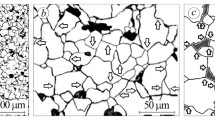Conclusions
1. The maximum long-term corrosion strength in the NACE solution was recorded for the specimens welded under the conditions of specimens 2 (3.0 kJ/mm); their threshold stress was equal to 250 MPa (0.7σ0.2); for other types of specimens welded with a heat input of 6.0 kJ/mm and 1.25 kJ/mm the threshold stress was equal to 180 and 160 MPa, respectively.
2. In the experiments with a low strain rate of the metal the highest relative resistance was recorded for the specimens 2 and the resistance decreased in the sequence 2→1→3.
Similar content being viewed by others

References
H. E. Townsend, “Natural gas pipeline stress corrosion. A failure analysis,” Mater. Prot. Perform., No. 10, 33–37 (1972).
J. B. Vrable, “Stress Corrosion and hydrogen embrittlement behavior of line-pipe steel in underground environment,” W.V. Univ. Eng. Exp. Stat. Bull., No. 10, 260–271 (1973).
J. C. Turn, B. E. Wilde, and C. A. Troianos, “On the sulfide stress cracking of line pipe steels,” Corrosion, No. 9, 364–370 (1983).
N. S. Shparber, Sulfide Cracking and Prevention of this Process in Oil and Gas Processing Industries [in Russian], All-Union Scientific Research Institute of the Gas Industry, Moscow (1970).
V. I. Afanas'ev, Yu. V. Zakharov, and N. E. Legezin, “Selecting steels resistant to sulfide cracking for pipes of the Orenburg gas condensated deposit,” in: Corrosion and Protection of Welds of Gas and Gas Processing Equipment [in Russian], Vol. 2, All-Union Scientific Research Institute of Economics and Gas Industry, Moscow (1973), pp. 19–27.
E. P. Sheineman, “Hydrogen sulfide corrosion cracking of steel in the conditions of extraction of oil and gas,” in: Korr. Zashch. Neftegaz. Promyshl., No. 9, 24–28 (1978).
B. F. Perunov, “Industrial pipelines in deposits with hydrogen sulfide,” Stroit. Truboprovod., No. 4, 17–23 (1990).
A. G. Mazel', “Reliability of pipes and welded joints in transport of products with hydrogen sulfide,” Storit. Truboprovod., No. 4, 26–33 (1990).
A. G. Ivanov, “Nature of catastrophic failures of pipelines,” Dokl. Akad. Nauk SSSR, No. 2, 357–360 (1985).
É. M. Gutman, et al., Protecting Gas Lines of Oil Systems Against Hydrogen Sulfide Corrosion [in Russian], Nedra, Moscow (1988).
M. D. Getmanskii, É. Kh. Enikeev, Yu. G. Rozhdestvenskii, et al., Corrosion and Protection of Oil Equipment and Pipelines in Media with a High Content of Hydrogen Sulfide and Carbon Dioxide [in Russian], All-Union Scientific Research Institute of Organization and Economics in Gas Industries, Moscow (1984).
G. Herbsleb, R. K. Poepperling, and W. Sehwenk, “Occurrence and prevention of hydrogen induces stepwise cracking and stress corrosion cracking of low alloy pipeline steels,” Corrosion, No. 5, 247–250 (1981).
M. Kimura, N. Totsuka, T. Kurisu, et al., “Sulfide stress corrosion cracking of line pipe,” Corrosion, No. 4, 340–346 (1989).
B. V. Perunov, A. I. Paul', and O. I. Steklov, “Cracking of welded joints in hydrogen and sulfide media,” Fiz. Khim. Mekh. Mater., No. 3, 115–118 (1986).
Proceeding Conference American Society of Metals, Philadelphia (1984).
T. Hyodo, M. Iino, A. Ikeda, et al., “The hydrogen permeation and hydrogen-induced cracking behavior of linepipe in dynamic full scale tests,” Corrosion, No. 10/11, 1077–1098 (1987).
Y. Kobayashi, K. Ume, T. Hyodo, and T. Taira, “The resistance of welded linepipes to sulfide stress cracking,” Corrosion, No. 10/11, 1117–1135 (1987).
MR 185–86. Strength Calculations and Tests. Methods of Testing the Susceptibility to Corrosion Cracking of Steels and Alloys in Liquid Media [in Russian], All-Union Scientific Research Institute of Oil Engineering, Moscow (1986).
V. M. Tkach, V. S. Bender, R. K. Melékhov, and L. V. Kapinos, “Effect of sulfur in the weld metal of pipe steels on susceptibility to sulfide cracking,” Fiz. Khim. Mekh. Mater., No. 6, 51–55 (1992).
Additional information
E. O. Paton Electric Welding Institute, Academy of Sciences of the Ukraine, Kiev. G.V. Karpenko Physico-mechanical Institute, Academy of Sciences of the Ukraine, L'vov. Translated from Fiziko-Khimicheskaya Mekhanika Materialov, Vol. 29, No. 2, pp. 52–56, March–April, 1993.
Rights and permissions
About this article
Cite this article
Tkach, V.N., Kapinos, L.V. & Melekhov, R.K. Corrosion cracking of welded joints in a pipe steel in a hydrogen-sulfide medium. Mater Sci 29, 151–154 (1993). https://doi.org/10.1007/BF00558814
Received:
Issue Date:
DOI: https://doi.org/10.1007/BF00558814



